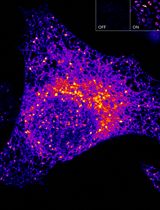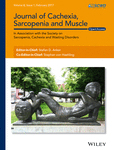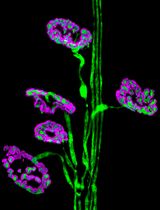- EN - English
- CN - 中文
Immunohistochemical Staining of TLR4 in Human Skeletal Muscle Samples
人类骨骼肌样本中TLR4的免疫组化染色
发布: 2019年01月20日第9卷第2期 DOI: 10.21769/BioProtoc.3144 浏览次数: 5937
评审: Anonymous reviewer(s)

相关实验方案

高灵敏且可调控的 ATOM 荧光生物传感器:用于检测细胞中蛋白质靶点的亚细胞定位
Harsimranjit Sekhon [...] Stewart N. Loh
2025年03月20日 1433 阅读
Abstract
Growing evidence suggests the involvement of TLR4, a receptor in the innate immune system, in muscle loss in uremia. Recently, we have evaluated TLR4 in human skeletal muscle from chronic kidney disease patients, by immunohistochemistry and image analysis. Unlike the commonly-used Western blot method, immunohistochemistry allows for the observation of protein distribution in the intact tissue while, image analysis, its quantification. In fact, our data highlighted our hypothesis that an enhanced TLR4 skeletal muscle cell expression contributes to the activation of the downward inflammatory pathway in uremic sarcopenia. In this protocol, we describe the procedure for immunostaining TLR4 in human skeletal muscle and for quantifying it by image analysis.
Keywords: Human skeletal muscle (人体骨骼肌)Background
TLRs are a family of receptors in the innate immune system that play crucial roles in the early defense stage against foreign agents (Aderem and Ulevitch, 2000; Takeda and Akira, 2001; Kawai and Akira, 2010). TLR4 recognizes pathogen-associated or endogenous antigens with common molecular patterns, including debris from apoptotic and necrotic cells (Mkaddem et al., 2010), heat shock proteins (Andersson et al., 2018) and oligosaccharides (Barrera et al., 2015). In addition, the activation of TLRs is an important link between innate and adaptive immune systems (Takeda and Akira, 2001). An emerging hypothesis underpins the role of innate immunity in the development and progression of uremic cachexia as observed in cancer (Zhang et al., 2017) and cardiac cachexia (Avlas et al., 2015) and there is also growing recognition that uremia stimulates inflammation, thus regulating the pathways leading to muscle catabolism (Jankowska et al., 2017). Among TLRs, TLR4 is involved in muscle loss, by the engagement of several ligands which induce and amplify the inflammatory response through the activation of the transcription factor NF-κB (Takeda and Akira, 2001).
Recently, we have demonstrated, both ex vivo and in vitro, that in chronic kidney disease (CKD) uremia promotes muscle inflammation through an up-regulation of TLR4. In turn, it activates downward inflammatory signals, such as TNF-α and NF-κB-regulated genes (Verzola et al., 2017). In human skeletal muscle, we have analyzed TLR4 expression by immunohistochemistry and Western blot, the most used approaches for protein analysis (Verzola et al., 2017). As far as we are aware, most of scientific reports written in the last 5 years, available on https://www.ncbi.nlm.nih.gov/pubmed, mainly evaluate skeletal muscle TLR4 expression by Western blot, that determines its relative abundance within a muscle sample, but does not allow for the mapping of the distribution among the various fibers whereas Immunohistochemistry provides a “picture” and enables the observation of the protein in the intact tissue. However, since both methods have advantages and disadvantages, a combination of the two approaches is required to obtain a correct and complete characterization of TLR4 expression. In addition, the data obtained by immunohistochemistry on TLR4 protein expression, also provides details concerning its amount and distribution along the muscular fibers and the cellular components, supporting the hypothesis that an enhanced expression of TLR4 contributes to the upregulation of native immunity in CKD skeletal muscle cells. Furthermore, thanks to the computer-assisted image analysis and the resulting quantification of the intensity of staining, it was possible firstly, to differentiate between the 2 groups, the healthy patients and the CKD patients, and secondly to statistically evaluate each of them.
Materials and Reagents
- Pipette tips (StarLab, catalog numbers: S1111-3700 [10 µl], S1113-1700 [200 µl], S1111-6700 [1,000 µl])
- Aluminum foil (CA.DIS., catalog number: 50002.24)
- Petri dishes 60 mm (Euroclone, catalog number: ET2060)
- 50 ml conical tubes (Eppendorf, catalog number: E162071N)
- 15 ml conical tubes (Eppendorf, catalog number: E160926K)
- Disposable gloves (WRP, catalog number: D1502-18)
- S35 Feather disposable microtome blades (PFM Medica AG, catalog number: 02OK07500000)
- Adhesion microscope slides (Laboindustria S.p.A., catalog number: 33820)
- Coverslips for optical microscopy 24 x 50 x 0.16 mm (DiaPath, catalog number: 061051)
- Pap pen for immunostaining (Merck group, catalog number: Z377821-1EA)
- Paper towel (Paperdi, catalog number: RL1M180)
- Small brushes
- Vacuum Filter System 500 ml 0.45 μm (Euroclone, catalog number: EPVPE45500)
- DPBS (Euroclone, catalog number: ECB400L)
- Ethanol (ITW Reagents, catalog number: 141086)
- Xylene mix of isomers (Carlo Erba Reagents, catalog number: 392603)
- Paraplast Bulk (Tissue embedding medium) (Leica Biosystem, catalog number: 39602012)
- Eukitt (Fluka Analytical, catalog number: 03989)
- Deionized water
- Distilled water
- Methanol (Carlo Erba Reagents, catalog number: 414814)
- Hydrogen peroxide 30% in water (Merck, catalog number: 216763-M)
- Hydrochloric acid, 37% (Merck, catalog number: 30721-M)
- Bovine serum albumin (Merck, catalog number: A3912)
- Avidin/Biotin Blocking kit (Vector Laboratories, catalog number: SP-2001)
- Monoclonal Antibody to TLR4 (Abcam, catalog number: 76B357.1)
- Mouse IgG (Vector Laboratories, catalog number: I-2000)
- Biotinylated anti-mouse IgG (H+L) affinity purified (VectorLaboratories,catalog number: BA-2000)
- Streptavidin/HRP (Dako, catalog number: P0397)
- DAB (3,3’-diaminobenzidine tetrahydrochloride) Enhanced Liquid Substrate System (Merck, catalog number: D3939)
- Carazzi’s Hematoxylin (Bio-Optica, catalog number: W01030708)
- Paraformaldehyde powder EM grade (Polysciences, catalog number: 0380)
- Potassium chloride (KCl) (Carlo Erba Reagents, catalog number: 471177)
- Potassium phosphate monobasic (KH2PO4) (Carlo Erba Reagents, catalog number: 471687)
- Di-sodium hydrogen phosphate anhydrous (Na2HPO4) (Carlo Erba Reagents, catalog number: 480141)
- Sodium chloride (NaCl) (Carlo Erba Reagents, catalog number: 368257)
- Citric acid (CARLO ERBA Reagents, catalog number: 403727)
- Tri-sodium citrate dihydrate (Carlo Erba Reagents, catalog number: 479487)
- Sodium azide (NaN3) (Merck, catalog number: S-2002)
- 2% paraformaldehyde (pH 7.4) (see Recipes)
- PBS (for diluting secondary antibodies, streptavidin/HRP and washing and dissolving BSA) (see Recipes)
- Unmasking buffer (10 mM sodium citrate buffer, pH 6) (see Recipes)
- Buffer for diluting primary antibody (see Recipes)
- Peroxidase inhibition solution (see Recipes)
- Blocking solution (5% BSA) (see Recipes)
Equipment
- Tweezers (Thermo Fisher Scientific, catalog number: 10303611)
- Forceps (Exacta Optech, catalog number: 9204222)
- Coverglass forceps (Leica Biosystems, catalog number: 38DI26286)
- Sterile mono-use scalpel
- Beakers
- Glass-staining dishes with lid (Vetrotecnica, catalog number: 01406000)
- PMP vertical staining jars with lids (Vetrotecnica, catalog number: 06035500)
- Pipettes (0.5-10, 10-100 and 100-1,000 μl, Eppendorf, catalog numbers: 3111000.122, 3111000.149, 3111000.165)
- Leica Reichert-Jung 2040 autocut Microtome
- Histology Bath (Falc Instruments, catalog number: 610.1030.00)
- Metal base molds 24 x 24 mm (Leica, catalog number: 38013082)
- Tissue Embedding Rings (Biosigma, catalog number: 040272)
- Drying oven/bench top (Melag)
- Humidity chamber (Merck, catalog number: H6644)
- Light microscope (Leica, model: Leica DMLB, catalog number: 020-519.502)
- High-resolution digital camera (Leica, model: Leica DC 300F, catalog number: 12447115)
- Heating magnetic stirrer (Velp Scientifica, catalog number: F20500413)
- Fume cupboard (Bicasa, catalog number: Logica 1.2) Microwave oven Saturno (MG821ABH) (DPE Elettrodomestici, catalog number: 0277)
Software
- Image analysis software (Leica QWin) (Leica, Cambridge, UK)
- GraphPad Prism® (version 5.02) (GraphPad Software San Diego, CA, U.S.A.)
Procedure
文章信息
版权信息
© 2019 The Authors; exclusive licensee Bio-protocol LLC.
如何引用
Verzola, D., Milanesi, S., Costigliolo, F. and Garibotto, G. (2019). Immunohistochemical Staining of TLR4 in Human Skeletal Muscle Samples. Bio-protocol 9(2): e3144. DOI: 10.21769/BioProtoc.3144.
分类
免疫学 > 免疫细胞成像 > 共聚焦显微镜技术
细胞生物学 > 组织分析 > 组织染色
分子生物学 > 蛋白质 > 检测
您对这篇实验方法有问题吗?
在此处发布您的问题,我们将邀请本文作者来回答。同时,我们会将您的问题发布到Bio-protocol Exchange,以便寻求社区成员的帮助。
提问指南
+ 问题描述
写下详细的问题描述,包括所有有助于他人回答您问题的信息(例如实验过程、条件和相关图像等)。
Share
Bluesky
X
Copy link











